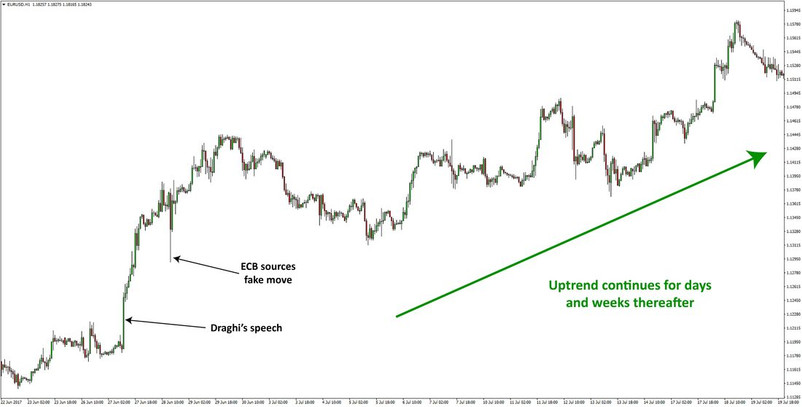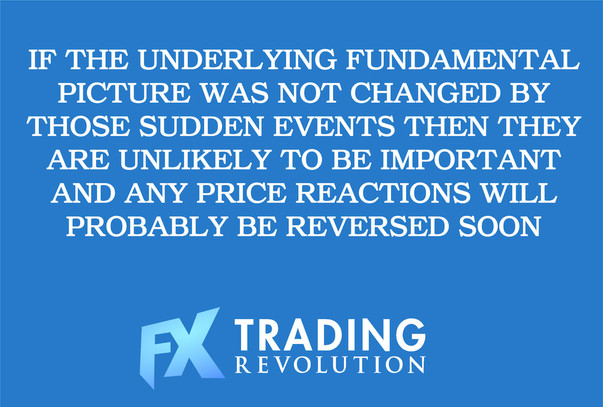We are often witnesses of hectic price action in the Forex market which in most cases leaves traders scratching their heads wondering why and how things happened.
Most often, the trigger for such a sharp move is some kind of a news story, whether scheduled on the economic calendar or unanticipated - causing the price to momentarily swing up and/or down in the range of 100 pips and leading to many stops being triggered and many traders losing money.
What’s even worse, those sharp moves are very often completely reversed and the market continues in the previous direction anyway! Those who got their stops taken out, lament about all the profit they could have made while those who held their positions are happy that they are still ending with a profit after all.
Perhaps, the happiest group of traders in these kinds of situations are the ones who faded the sharp move – entered in the contrary direction (either bought the dip or sold the rally) and thus took a nice and fast profit from the situation.
In this article, we are going to specifically discuss these situations, and also, how to differentiate between important fundamental developments and noise in the markets. Or, to put it simply – how to identify a true move versus a fake move.
Also, keep in mind that the principles explained here in a way complement the strategies we explained in our “High Probability Tall Candle Reversal Forex Strategy” post found here.
While the tall candle reversal strategy focused entirely on the technical aspect of these situations, in this article we’ll look at the fundamental aspects and why those moves occurred. In addition, we’ll look at the exact same example of EURUSD and examine what were the fundamentals underneath the whole chaotic price action in those minutes. You can then read the Tall Candle Reversal Strategy article and combine the insights found there with the ones in this article.
So, let’s look at the aforementioned example of Euro and EURUSD in June 2017.
The Euro was in the midst of its fastest appreciation in months amid the impending change of the monetary stance at the ECB from a strongly dovish to a more hawkish one. The ECB needed to prepare the market for tighter policy after 2 years of massive quantitative easing as the Eurozone economy was robustly improving and inflation has started to tick upwards.
The confirmation that the ECB is ready to withdraw stimulus and the acknowledgment that things are improving came from President Mario Draghi in a speech on June 27 where he said: “deflationary forces are diminishing and are being replaced by inflationary forces”.
This was a big declaration and one that sent the Euro higher by more than 160 pips against the Dollar by the end of the trading day. Such a big decision at one of the world’s major central banks was a huge deal and it was sure to affect the markets. The uptrends in Euro pairs were nowhere near done given the significance of such a shift in the central bank’s stance.
However, on the next day, out of nowhere news broke quoting ECB sources that policymakers at the ECB are worried that markets misinterpreted the message of President Draghi and the appreciation of the Euro was too fast. The single currency plummeted immediately by 85 pips against the Dollar as a result.
Now, for anyone who has followed things closely and who understood the big picture in the overall situation knew that this move was not going to last.
Such a vague statement suddenly coming from an even vaguer and unspecified source could do little to affect the broad and stellar bull trend in the Euro that was by that time well underway. Essentially, there was no real reason for the sharp drop in the Euro other than a knee-jerk and rushed reaction. And indeed, soon enough the whole move was erased and the Euro and the EURUSD pair continued to march higher in the next days and weeks.

This example highlights why it’s crucial to only focus on the most important and underlying aspects of the fundamentals rather than on every little piece of news. In fact, most of the fundamental news that is released is just noise and should be completely ignored when making trading decisions.
To better determine if a news story/event is noise or important we need to ask ourselves some simple questions such as “Does this news/story change the overall big picture?”, “Is this event powerful enough to tilt the big picture in the other direction?”, or “How much does this change the broader dynamics that are already in play?”.
If the answers are no or very little then you can expect, with a high degree of confidence that the move will be reversed sooner or later as was the case with the Euro.
The most important concept to understand from this is that if the underlying fundamental picture was not changed by those sudden events then they are unlikely to be important and any price reactions will probably be reversed soon. The fact that the ECB was worried that markets are getting ahead of themselves didn’t change the fact that they are going to tighten monetary policy by tapering their multi-year quantitative easing program, nor the fact that the Eurozone economy was showing notable, broad and sustainable improvements.
Now, whether such news stories are created deliberately as a way to manipulate prices is hard to tell, but one thing is clear: it happens and we must be prepared for those kinds of situations.
This is especially true for swing and longer-term traders because such a sharp knee-jerk reaction can cause them to close longer-term positions only to see them moving in profit later.

So, when trading fundamentals it’s absolutely crucial to differentiate between important fundamental events and those that are just noise because this will enable you to more accurately predict whether a move is true or likely to be fake.
Viewing the market in this way can be useful in most trading situations, but especially in trading breakouts - particularly in avoiding fake-outs. Basically, a rule of thumb is that if the fundamental event is not important enough it’s unlikely to cause a big breakout of an important technical level on the charts.





